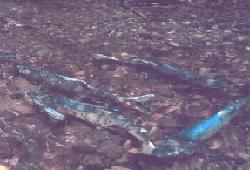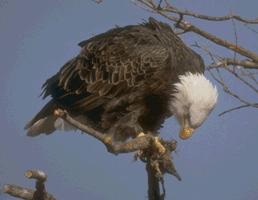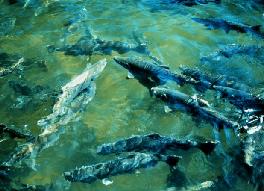forum
library
tutorial
contact

Ecosystem Keystone:
Salmon Support 137 Other Species
by Ed Hunt
Environment News Service, July 6, 2000
|
the film forum library tutorial contact |

|
Ecosystem Keystone:
by Ed Hunt
|
OLYMPIA, Washington,(ENS) - More than 137 species of fish and wildlife - from orcas to caddisflies - depend on the Northwest salmon for their survival, a revelation that makes salmon recovery efforts of far greater importance than the protection of a single species.
A new report released by Washington Department of Fish and Wildlife has found that salmon play a vital role in watershed health, transporting nutrients from the ocean back to the watershed.
The discovery could spark major changes in fishery and hatchery management and the direction of salmon recovery efforts in the future.
"It's not just salmon, it's the ecosystem," said Jeff Cederholm, a salmon research scientist with Washington Department of Natural Resources, principal author of the report. "We need to start giving out the whole story of what made the ecosystem; it's an abundance of fish on the spawning grounds."
Orcas, also known as
killer whales, rely on
salmon for their food
(Photo courtesy National
Oceanic and Atmospheric
Administration)
 Northwest species now
struggling because of
depleted salmon runs
include the bald eagle,
grizzly bear, black
bear, osprey, harlequin
duck, Caspian tern and river otter.
Northwest species now
struggling because of
depleted salmon runs
include the bald eagle,
grizzly bear, black
bear, osprey, harlequin
duck, Caspian tern and river otter.
"They are all so closely tuned with the pacific salmon that many of these populations are in decline, partially due to declining food supply," Cederholm said.
The report, "Pacific Salmon and Wildlife," is a collaboration of a number of organizations through Washington Department of Fish and Wildlife and Department of Natural Resources. It brings together 500 scientific studies and decades of research to document the vital role salmon play in the overall health of ecosystems.
Pacific salmon are unique in that they die after they reproduce. When salmon return from the ocean, they bring vital nutrients with them to the watersheds where they were hatched. Through their decomposing carcasses, the salmon spawning process offers a vital source of food not just for salmon and other fish species, but for a whole host of organisms in the watershed.
Prior research has documented that salmon rely on the decomposing salmon carcasses as a major food source. National Marine Fisheries Service biologist Robert Bilby found that 40 to 60 percent of the stomach contents of young salmon and steelhead could be traced to salmon carcasses.
When salmon carcasses were placed in streams, the density of young coho salmon in those streams increased compared to other sites. The weight and amount of fat found in the coho increased wherever the carcasses were put in the river. The healthier and better fed salmon are before they leave their home watershed, the better chance they have of returning to spawn.
Spawning salmon
(Photo courtesy Cmdr. John Bortniak, NOAA Corps)
 Earlier this year, researchers
calculated that due to
declining salmon runs, just five
to seven percent of the
nutrients originally delivered
by salmon to streams is now
available. The streams are
starving from lack of salmon,
and that lack of salmon is hurting the ability of the next generation of
salmon to survive.
Earlier this year, researchers
calculated that due to
declining salmon runs, just five
to seven percent of the
nutrients originally delivered
by salmon to streams is now
available. The streams are
starving from lack of salmon,
and that lack of salmon is hurting the ability of the next generation of
salmon to survive.
Cederholm, who has been studying the link between salmon nutrients and ecosystem health for more than a decade, said he thinks the salmon life cycle evolved as a "primitive form of childcare." By going out into the ocean, feeding and storing nutrients, then returning to their stream of origin to spawn and die enriches the habitat, giving the young salmon a better chance for survival.
"They achieved total ecosystem enrichment," Cederholm says. "Salmon really are a keystone species. ... For example, the reestablishment of the grizzly bear may be impeded by not having the primary food source it evolved with. The abundance of all these things is interrelated."
Of the 137 species documented as dependent on salmon, 41 are mammals including orcas, bears and river otters, 89 are birds, including bald eagles, Caspian terns and grebes, five are reptiles and two are amphibians.
"Production is based on food and space and you must have both," Cederholm said. "Pacific salmon are the food base for much of what lives in the watershed."
Bald eagles depend on salmon for food
(Photo by Robert Fields courtesy U.S. Fish & Wildlife Service)
 When the salmon disappear,
their importance becomes
evident. Cederholm points to
the example of McDonald
Creek in Glacier National
Park. In 1981, more than 600
bald eagles gathered to feed
on kokanee salmon
carcasses. When an
non-native shrimp was introduced in an adjacent lake, the shrimp
competed with the salmon for an important food source -
zooplankton - and the salmon run failed. By 1989, only 25 eagles
were found at McDonald Creek. The loss of salmon caused what
Cederholm calls an "ecosystem collapse."
When the salmon disappear,
their importance becomes
evident. Cederholm points to
the example of McDonald
Creek in Glacier National
Park. In 1981, more than 600
bald eagles gathered to feed
on kokanee salmon
carcasses. When an
non-native shrimp was introduced in an adjacent lake, the shrimp
competed with the salmon for an important food source -
zooplankton - and the salmon run failed. By 1989, only 25 eagles
were found at McDonald Creek. The loss of salmon caused what
Cederholm calls an "ecosystem collapse."
"We think we see one little change," said Cederholm. "But behind it, it's the whole ecosystem."
The Washington Department of Fish and Wildlife has been placing hatchery salmon carcasses in streams to try and restore some of the lost nutrients. Andy Appleby, aquaculture coordinator for the hatchery division of Washington Department of Fish and Wildlife said the state distributed 120,000 carcasses in 23 watersheds last year as part of the state's nutrient enhancement program.
Now entering its fifth year, the nutrient enhancement program has doubled every year, Appleby said, and there are plans to continue expanding the program. Oregon also has a smaller, but growing carcass distribution program.
Cederholm says the nutrient enhancement program is a good stopgap measure to get much needed nutrients back into the streams, but it is a far cry from what is needed to restore streams to their historically nutrient rich state.
Some hatchery practices can adversely affect wild fish
(Photo courtesy OAR/National Undersea Research Program)
 Historically, salmon
carcasses likely totaled
three to five tons, for every
kilometer of stream every
year, Cederholm said.
"Anything that gets marine
derived nutrients on the
spawning ground must happen right now to give wild fish a boost."
Historically, salmon
carcasses likely totaled
three to five tons, for every
kilometer of stream every
year, Cederholm said.
"Anything that gets marine
derived nutrients on the
spawning ground must happen right now to give wild fish a boost."
Cederholm thinks change must occur in how salmon harvesting is managed.Todays salmon harvests are based on a system called Maximum Sustained Yield under which the number of fish allowed to spawn is based on generating the greatest number of harvestable fish.
The report says managing using this measure drastically reduces the number of fish that should be reaching the watershed to spawn, and the nutrients in the stream, creating a spiral of lost production.
New harvest strategies need to be developed that address the nutrient delivery to freshwater ecosystems, yet there is little information available on which to base these harvest levels.
Sport and commerical fishing have already been cut back to return more fish to the spawning grounds. Yet, Cederholm says in the short term, drastic measures need to be taken to make sure all wild fish get to their spawning streams.
Fourteen Pacific Northwest populations of salmon and steelhead, like this chinook salmon, are listed as threatened
(Photo courtesy Pacific Northwest National Laboratory)
 "We are very much in an emergency situation," Cederholm said. "So I have this personal view that we must stop killing these
wild fish, we must stop impeding their progress to the spawning
grounds. If Gresh is right, if we are returning just five percent of
these nutrients to the spawning ground, we must rebuild those runs.
The wild fish that are left are the nucleus to start from."
"We are very much in an emergency situation," Cederholm said. "So I have this personal view that we must stop killing these
wild fish, we must stop impeding their progress to the spawning
grounds. If Gresh is right, if we are returning just five percent of
these nutrients to the spawning ground, we must rebuild those runs.
The wild fish that are left are the nucleus to start from."
"All Northwest wild salmon must escape the fishery," Cederholm stressed. That includes all fishing, and all incidental killing of wild salmon, direct or indirect, including commercial fishing, and even the mortality related to catch and release of sport fishing."
Cederholm says hatchery production serves no purpose other than to "perpetuate the false idea that salmon are still abundant." Record numbers of fish passed the counting stations on the Columbia River this spring, yet almost all are hatchery fish.
"I think we should unilaterally get rid of any semblance of artificial production and put the money we're spending on hatcheries into restoring natural production," Cederholm said. "The money invested in hatcheries over the years has been a waste of money. It gives a false perception of abundance and takes money away from habitat protection. I can't believe with the level of science we have now, we continue to perpetuate artificial fish production."
The report: "Pacific Salmon and Wildlife: Ecological Contexts,
Relationships, and Implications for Management," is available from
Washington Department of Fish and Wildlife at:
www.wdfw.wa.gov/publications/00063/
To get a copy of the report, email: johnsdhj@dfw.wa.gov
Related Pages:
Cederholm report is also available at www.bluefish.org/cederholm.pdf
learn more on topics covered in the film
see the video
read the script
learn the songs
discussion forum
